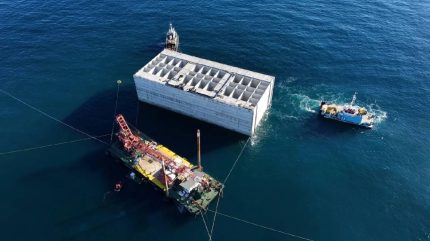
Global construction group Webuild has confirmed the installation of the first of 35 mega caissons for Genoa’s New Breakwater, marking a key phase in the redevelopment of the Italian city’s coastal infrastructure.
The new breakwater is designed to enable the Port of Genoa to receive large container ships that exceed 400m in length and 60m in width, as well as specific cruise ships.

Discover B2B Marketing That Performs
Combine business intelligence and editorial excellence to reach engaged professionals across 36 leading media platforms.
Genoa’s new breakwater will be built with its foundation on a seabed that reaches a depth of 50m. When completed, the structure will have a total length of approximately 6,000m.
Construction will use about seven million tonnes of rock material for the base, and precast concrete elements will be placed on top. More than 90 cellular caissons are planned for the first 4,000m of the breakwater.
The first caisson is a concrete structure measuring 33m in height, 67m in length, and 30m in width, and now stands 50m below sea level.
Construction will take place in two stages. The first stage is scheduled for completion in 2026 and involves creating a new entrance to the port from the east that is more than 300m wide. This phase aims to provide additional manoeuvring space for vessels.

US Tariffs are shifting - will you react or anticipate?
Don’t let policy changes catch you off guard. Stay proactive with real-time data and expert analysis.
By GlobalDataThe second stage, set for completion in 2030, includes widening the Sampierdarena Canal to 400m. This work is intended to improve operating conditions and capacity at all terminals located in Genoa’s main commercial area.
The PerGenova Breakwater consortium, led by Webuild with Fincantieri Infrastructure Opere Marittime, Fincosit, and Sidra as partners, is overseeing the project for the Western Ligurian Sea Port Authority.
Manufacture of the caisson took place at the Vado Ligure basin, where work on the production of both mega and standard caissons continues.
The consortium used a semisubmersible barge, Tronds Barge 33, equipped with a pump-controlled system to submerge and surface the caisson for installation.
This approach reportedly enabled precise placement at unprecedented depths. Seabed remediation and consolidation have progressed alongside caisson construction, stated the company.
The breakwater project is among the largest infrastructure initiatives in Italy and is supported by funding from the National Recovery and Resilience Plan.
It ranks as the largest intervention aimed at upgrading an Italian port and is part of a coordinated set of projects intended to improve road, rail, and sea access to the Port of Genoa and Liguria, stated Webuild.
The construction is expected to create approximately 1,000 direct and indirect jobs.
Webuild is also building the Terzo Valico di Giovi-Genoa Junction Project.
Both projects are intended to strengthen Genoa’s position within the Rhine-Alpine Corridor of the Trans-European Transport Network.
In August, Fisia Italimpianti, a subsidiary of Webuild Group, and its consortium partners handed over Lot 2 of the Riachuelo System to Agua y Saneamientos Argentinos in Buenos Aires, Argentina.



